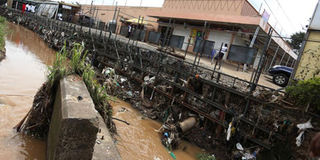Just what is wrong with city rainwater drains?

The mess at a narrowly constructed bridge in Nairobi South ‘C’. Residents want it rebuilt to avoid flash floods. PHOTO | BILLY MUTAI | NATION MEDIA GROUP
What you need to know:
Unfortunately, all this water was allowed to go down the drain – literally! And that contributed to the flooding problems that were experienced. The greater culprit, however, are the roads.
The meteorological office is on Ngong Road – a medium size road in the city. This road is a single carriageway measuring about 10m in width.
In September last year, I explained why rainfall measurements are normally recorded in millimetres. It is because this unit conveniently allows us to know how many litres of water we can get from a given surface area.
We found that if one litre of water is poured into a container of one square metre in base area it would rise to just one millimetre high. Therefore, the millimetres of rainfall that are reported by the meteorological department are simply the number of litres of rainwater that fell in every square meter of ground.
So how much rainwater did Nairobi get recently on the days when the entire city experienced severe flooding earlier this month? Data from the Kenya Meteorological Service shows that 73mm was recorded at the Dagoretti Corner station on May 10 and 116mm on May 11.
This means that the area around Dagoretti Corner received 73L per square metre on the first day of heavy rain and 116L per square metre on the second day. Now think about it: a typical two-bedroom house has a surface area of about 100 square metres, therefore, it collected 7,300L and 11,600L on those two days respectively. That was more than enough for all household uses for the entire month!
GREATER CULPRIT
Unfortunately, all this water was allowed to go down the drain – literally! And that contributed to the flooding problems that were experienced. The greater culprit, however, are the roads.
The meteorological office is on Ngong Road – a medium size road in the city. This road is a single carriageway measuring about 10m in width. Therefore, every metre along it collected 730L of rainwater on the first day and 1,160L on the second day.
Now that’s just one metre; one kilometre collected 1,000 times these figures. That is 730,000L and 1,160,000L respectively. In other words, each kilometre of an average Nairobi road collected about one million litres of rainwater on each of these two days!
Now you have a good picture of the magnitude of the problem that road engineers are faced with. Thankfully, though it’s not a simple problem, it’s also not insoluble!
Fell gradually
The first thing to remember is that all this water did not come down at an instant: it fell gradually over a 5-hour period. Secondly, there are two major factors to be considered when designing a drainage system: the size and the gradient.
The volume of water that passes throw is determined by the size and the velocity of flow. Flooding will occur if the drain is too small or if the water is not “encouraged” to flow at high speed.
I have made casual (non-scientific) observations of drainage system in Nairobi and come to the conclusion that the problem is not their size; it is lack of gradient to accelerate that rainwater away. As a result, we get many paddles of stagnant water in the drain systems after every drizzle. Stagnation encourages siltation which clogs the system and farther exacerbates the problem.




